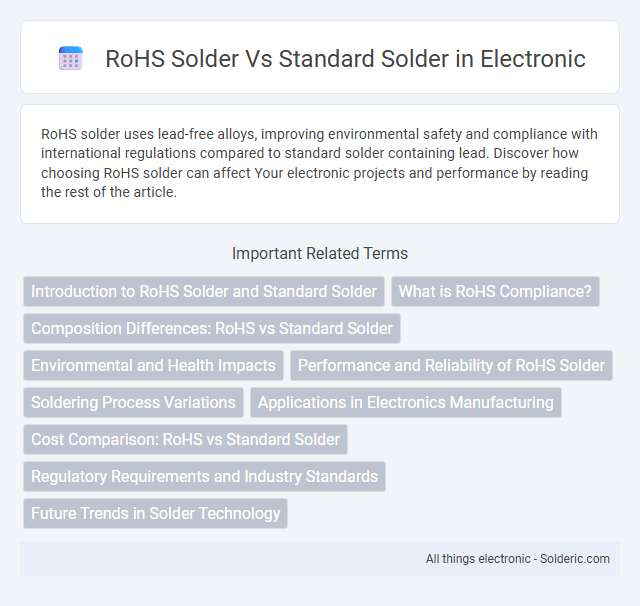RoHS solder uses lead-free alloys, improving environmental safety and compliance with international regulations compared to standard solder containing lead. Discover how choosing RoHS solder can affect Your electronic projects and performance by reading the rest of the article.
Comparison Table
| Feature | RoHS Solder | Standard Solder |
|---|---|---|
| Lead Content | Lead-free (usually Sn, Ag, Cu) | Contains lead (typically SnPb alloy) |
| Environmental Compliance | Complies with RoHS Directive | Does not comply with RoHS |
| Melting Point | Higher melting point (~217-220degC) | Lower melting point (~183degC) |
| Toxicity | Non-toxic, safer for environment | Contains toxic lead |
| Wettability | Good, but slightly less than leaded solder | Excellent wettability |
| Mechanical Strength | Comparable strength | Strong mechanical bonds |
| Application | Used in electronics with environmental regulations | Used in non-restricted electronic assembly |
Introduction to RoHS Solder and Standard Solder
RoHS solder is a lead-free alloy designed to comply with the Restriction of Hazardous Substances Directive, reducing environmental and health risks compared to standard solder that contains lead. Standard solder typically consists of a tin-lead mixture with a lower melting point but poses toxicity concerns. Choosing RoHS solder ensures your electronic assemblies meet regulatory standards without compromising performance and durability.
What is RoHS Compliance?
RoHS compliance refers to adherence to the Restriction of Hazardous Substances Directive, which limits the use of specific hazardous materials like lead, mercury, and cadmium in electrical and electronic equipment. RoHS solder is lead-free and uses alternative alloys such as tin-silver-copper (SAC) to meet environmental and health safety standards. Standard solder typically contains lead, which makes it non-compliant with RoHS regulations and less environmentally friendly.
Composition Differences: RoHS vs Standard Solder
RoHS solder primarily consists of a lead-free alloy, such as tin-silver-copper (Sn-Ag-Cu), while standard solder traditionally contains a significant amount of lead, typically around 60% tin and 40% lead (Sn60Pb40). The elimination of lead in RoHS solder reduces environmental and health risks, aligning with EU Directive 2011/65/EU regulations. RoHS solder alloys exhibit higher melting points, around 217-220degC, compared to standard solder's lower melting point near 183degC.
Environmental and Health Impacts
RoHS solder contains reduced levels of hazardous substances such as lead, cadmium, and mercury, significantly lowering environmental pollution and toxic waste generation compared to standard solder. This compliance with the Restriction of Hazardous Substances Directive minimizes health risks for electronics workers by reducing exposure to toxic fumes and heavy metals. Using RoHS solder supports sustainable manufacturing practices and enhances product recyclability, aligning with global environmental protection standards.
Performance and Reliability of RoHS Solder
RoHS solder, typically composed of tin, silver, and copper (SAC), offers enhanced thermal fatigue resistance and improved mechanical strength compared to traditional lead-based solder. Its performance ensures lower risk of joint failure in high-temperature applications, making it highly reliable for electronics requiring long-term durability. Despite slightly higher melting points, RoHS solder maintains excellent wetting properties, which contribute to consistent and robust electrical connections.
Soldering Process Variations
RoHS solder typically requires higher soldering temperatures compared to standard solder due to its lead-free composition, which can affect the thermal profile of your soldering process. This variation demands precise control of heat to prevent damage to sensitive components and ensure proper joint formation. Adjustments in soldering techniques, such as longer preheating times and modified reflow profiles, are often necessary to accommodate the different melting characteristics of RoHS solder.
Applications in Electronics Manufacturing
RoHS solder, containing lead-free alloys like tin, silver, and copper, is essential in electronics manufacturing to meet environmental regulations restricting hazardous substances, ensuring compliance in consumer devices and industrial equipment. Standard solder typically includes lead, offering lower melting points and easier flow, but faces declining use due to health and environmental concerns. Your choice of RoHS solder supports sustainability and aligns with strict industry standards for electronics assembly and reliability.
Cost Comparison: RoHS vs Standard Solder
RoHS solder typically costs 10-20% more than standard solder due to the use of lead-free alloys like tin-silver-copper, which require higher processing temperatures and more expensive materials. Standard solder contains lead, reducing manufacturing complexity and expenses, resulting in lower price per kilogram compared to RoHS-compliant alternatives. Despite higher upfront costs, RoHS solder reduces environmental liabilities and potential regulatory fines, offering long-term economic benefits in lead-restricted markets.
Regulatory Requirements and Industry Standards
RoHS solder complies with the Restriction of Hazardous Substances directive, limiting lead, mercury, cadmium, and other harmful materials to protect human health and the environment. Standard solder may contain lead and other restricted substances not permitted under RoHS regulations, making it less suitable for electronics subject to strict environmental standards. Meeting RoHS compliance ensures Your products adhere to global industry standards, facilitating market access and regulatory approval.
Future Trends in Solder Technology
RoHS solder, free from lead and hazardous substances, aligns with stringent environmental regulations and is becoming the industry standard due to increasing demand for eco-friendly electronics. Advancements in solder alloys emphasize improved thermal resistance, electrical conductivity, and mechanical strength to support miniaturized and high-performance components. Your future-proof designs will benefit from emerging lead-free formulations that balance reliability with sustainability, driving innovation in electronics manufacturing.
RoHS solder vs standard solder Infographic

 solderic.com
solderic.com